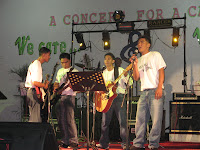Joan Cosme (not her real name), 35, sits down on a big rock to put on a pair of black rubber boots. She then straps a spotlight on her forehead and grabs her metal tools. She’s now ready to enter her family’s
“usok” or private mine somewhere in Itogon, Benguet, one hour ride from Baguio City.
She crouches to enter a small opening, about four feet by three feet, framed by braches of pine tree, at the side of a mountain. She walks through a narrow, dark, moist tunnel, “duck walk” fashion, for a distance of 250 feet from the entrance. Her only source of light is her improvised rechargeable spotlight
“mineros” in these parts have so ingeniously put together.
“The soil here is soft that’s why we can’t make a big tunnel. The timber cannot hold the weight of the soil and rocks,” she explains.

(The mountains of Itogon, Benguet viewed from Virac)
Barely five feet, Joan is a fulltime mother and wife but these last few days, she has been helping her husband work in their private mine. This is her fifth day of working in their “usok.” “It’s been years ago since I last worked inside the tunnel. But I need to help Armando (her husband) now because we need money for our children’s education,” she says. Joan, a Kankana-ey, has six children; the eldest is 12, the youngest is 4.
Negotiating the way to the Cosmes’ "usok” in the mountain is an adventure by itself. It’s almost like sliding down a mountain positioned in a 90-degree angle. At first you step on rocks as you descend into a steep, winding path. But as you go deeper down into the mountain, you start running and sliding down more often because there are no longer rocks or big stones to step on, but only bare soil and a few branches of trees to hold on to. At one point, you even have to turn around and crawl downward because the trail seems to have disappeared so suddenly.
(The entrance to Joan's usok)
After about 20 minutes of doing the walk-run-slide-crawl combination, you reach the mining site, less than 200 meters above the base of the mountain. Sweat now runs down your temple.
“I had fever the first night I came here. My muscles were sore I couldn’t even raise my legs. But after a few days, I finally got used to going up and down the mountain again,” she says. But the real adventure starts once you are inside the “usok,” according to Joan.
After several minutes of “duck walk,” Joan now heads to a “destino,” or a particular mining hole. If the “usok” is the big hole, the “destinos” are sub-holes. Her husband, two brothers, a sister-in-law, and two male cousins are scattered in two “destinos.” In these parts, small-scale mining remains to be a family affair.
It’s quiet inside the “usok” except for the sound of tools hitting rocks, and short, low conversations. Joan adjusts her spotlight to focus on a blue vein that runs vertically on the side of the “destino.” She says, “This rock has gold.” The soil is soft so she carefully chips off portions of this ore.
“Destino,” Joan explains, is a Kankana-ey translation for “destiny.” Miners don’t just chip off soil or rocks indiscriminately; they look for “naba” or gold ore. “Once we find gold ore in a particular area, this becomes our ‘destino,’ or destiny,” Joan explains.
She points at a few “destinos” of different sizes and directions inside the mine: “diretso,” “ulsod,” and “patangad.” Just go straight to a “diretso” but you may need a rope or a ladder to go down to an “ulsod.” There’s also a hole going up, called “patangad.”
No, Joan isn’t afraid of working inside this dark, moist mine. The only thing she dreads most is what miners call “gas.” She describes it as hot air being emitted by elements inside the tunnel, including the carbon dioxide being given off by every person working inside the “usok.”
“You feel warm and you couldn’t breathe. It’s like you’re being suffocated,” she says, describing how it feels when “gas” forms inside the mine. A few seconds without fresh oxygen could be fatal for everyone inside the “usok.”
As Joan walks deeper into the “destino,” cool air blows in from the entrance of the tunnel. Another male cousin has just turned on a big blower near the tunnel’s entrance to pump in fresh air into the “usok” to prevent suffocation. Joan breathes in deeply, taking in all the oxygen she could inhale.
After three hours of chipping away “naba,” (gold ore) and putting them in her sack, Joan decides it’s time to go out. She emerges from the tunnel with mud splattered on her forehead, nose, and clothes, her hands black with mud. She laughs at how she looks. “I look like a ghost!” She washes her hand at a small pail filled with blackish water outside the “usok” before unfastening her spotlight.
“I hope this sack gives me at least a gram of gold,” she says. With the way she works, Joan seems to be destined for success.
 Apong Patani and her friends in front of the Baguio Botanical Garden. She claims to come from the boundary of Bontoc and Kalinga.
Apong Patani and her friends in front of the Baguio Botanical Garden. She claims to come from the boundary of Bontoc and Kalinga. This is me and two of my good, old, reliable friends. Hehe! Two of us come from Mountain Province, while our other friend is of Mountain Province-Benguet parentage.
This is me and two of my good, old, reliable friends. Hehe! Two of us come from Mountain Province, while our other friend is of Mountain Province-Benguet parentage. Igorot priests from Mountain Province and Benguet give a concert-for-a-cause at the Baguio Convention Center.
Igorot priests from Mountain Province and Benguet give a concert-for-a-cause at the Baguio Convention Center.









